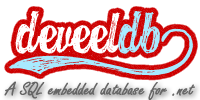 |
DeveelDB
20151217
complete SQL database system, primarly developed for .NET/Mono frameworks
|
 |
DeveelDB
20151217
complete SQL database system, primarly developed for .NET/Mono frameworks
|
Classes | |
| interface | ITableStateHandler |
| interface | ITriggerListener |
| interface | ITriggerManager |
| class | OldNewTableState |
| class | QueryContextExtensions |
| class | QueryExtensions |
| class | SystemContextExtensions |
| class | TableEvent |
| Exposes the context of an event fired on a table. More... | |
| class | Trigger |
Represents an event fired at a given modification event (either INSERT, DELETE or UPDATE) at a given time (BEFORE or AFTER). More... | |
| class | TriggerBody |
| class | TriggerEvent |
| class | TriggerEventEventTypeExtensions |
| class | TriggerEventInfo |
| An object that defines the arguments of an event, used to find triggers associated. More... | |
| class | TriggerEventRouter |
| class | TriggerException |
| class | TriggerInfo |
| Defines the information about a trigger on a table of the database, such as the event on which is fired and the procedure to execute. More... | |
| class | TriggerListenTests |
| class | TriggerManager |
| class | TriggerTests |
| class | UserSessionExtensions |
Enumerations | |
| enum | TriggerEventType { TriggerEventType.Insert = 0x001, TriggerEventType.Delete = 0x002, TriggerEventType.Update = 0x004, TriggerEventType.Before = 0x010, TriggerEventType.After = 0x020, TriggerEventType.BeforeInsert = Before | Insert, TriggerEventType.BeforeDelete = Before | Delete, TriggerEventType.BeforeUpdate = Before | Update, TriggerEventType.AfterInsert = After | Insert, TriggerEventType.AfterUpdate = After | Update, TriggerEventType.AfterDelete = After | Delete, TriggerEventType.AllBefore = BeforeInsert | BeforeDelete | BeforeUpdate, TriggerEventType.AllAfter = AfterInsert | AfterDelete | AfterUpdate } |
| The different types of high layer trigger events. More... | |
| enum | TriggerType { TriggerType.Callback = 1, TriggerType.Procedure = 2 } |
| Enumerates the types of triggers, that can be volatile (like the Callback) or stored in the database. More... | |
|
strong |
The different types of high layer trigger events.
Definition at line 24 of file TriggerEventType.cs.
|
strong |
Enumerates the types of triggers, that can be volatile (like the Callback) or stored in the database.
| Enumerator | |
|---|---|
| Callback |
A trigger that exists only within a user session and notifies of an event directly to the user client. |
| Procedure |
Triggers that define a procedural body stored in the database system. |
Definition at line 22 of file TriggerType.cs.
 1.8.10
1.8.10